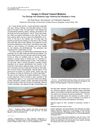Severe Marking-Nut Dermatitis
November 2012
in “
Dermatitis
”

TLDR A man got severe skin irritation after using marking nut sap for hair loss.
A 42-year-old man with a history of recurrent alopecia areata experienced severe marking-nut dermatitis after applying the sap of Semecarpus anacardium, commonly known as the marking nut, to his scalp as a treatment for hair loss. The application led to a burning sensation within an hour, followed by the development of erythema and blistering on his scalp, arms, neck, and trunk. Physical examination showed a thick dark-brown to black crust covering his entire scalp and bullae and erythema on his arms and trunk. Despite normal blood counts and liver, renal, and blood sugar levels, he was diagnosed with severe marking-nut dermatitis and prescribed oral prednisolone (40 mg daily) and amoxicillin-clavulanate. However, the patient was lost to follow-up. The marking nut has been used in traditional medicine for various ailments and is known to contain compounds with medicinal properties, including promoting hair growth, which was the intended use in this case. The nut's active compound, urushiol, can act as an irritant and allergen, leading to dermatitis that can last up to three weeks and potentially cause permanent pigmentation changes in dark-skinned individuals. The case emphasizes the importance of recognizing marking-nut dermatitis and considering renal function due to the nephrotoxic potential of the nut.





